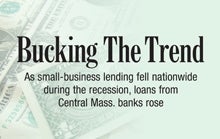Small Business Lending Up Locally, Down Nationally

Many banks around the country have not returned to their pre-recession levels of lending to small business, but on the whole, banks in Central Massachusetts have done the opposite, increasing their portfolios by several hundred million dollars since 2008.
Banks in this region, whose assets individually range from several million to several billion dollars, have seized lending opportunities left behind by bigger banks in the wake of the recession, bankers and lending experts said. And they have also benefited from the above-average strength of the state’s economy and Massachusetts’ unemployment rate, which is lower than the national rate.
Nationally, small-business loans — defined as commercial loans of $1 million or less — have fallen 14 percent for all banks, hitting their lowest point since 2006 in the third quarter of last year, according to data from the Federal Deposit Insurance Corp. compiled and analyzed by the Worcester Business Journal.
No matter how the most recent lending data is sliced and diced, it shows on the whole a picture of declining small business loans throughout the recession, which officially started in late 2007 and ended in the summer of 2009.
Banks with assets of $300 million to $500 million, which most closely fit the Central Massachusetts banking profile, have seen a 23-percent decline in small-business loans across the country.
Even savings institutions, of which there are about a dozen locally, saw their portfolios drop 7.5 percent in Massachusetts and 11.4 percent nationwide.
Trend Defier
Lending volume is down nationwide, but data shows that the opposite is true for the 27 banks based in Central Massachusetts. Led by local powerhouses Middlesex Savings Bank in Natick, Commerce Bank &Trust in Worcester, Avidia Bank in Hudson and Webster Five Cents Savings Bank in Webster, those institutions increased lending 16 percent, or $204.6 million, between the summer of 2008 and the end of 2011.
John McKenna, vice president and chief lending officer at Commerce Bank, which has increased small-business lending $31 million (20 percent) since 2008, said some larger national banks had to curtail lending to shore up their reserves in the face of losses. But community banks haven’t changed much about their lending requirements and strategies.
“Here in Central Mass, a number of good small banks stepped up and established new customer relationships,” McKenna said. “Our lending window, if we had one, has never been closed.”
McKenna said low interest rates have helped spur lending.
Bruce Spitzer, communications director for the Massachusetts Bankers Association (MBA), said low interest rates have helped in some ways, but they have also trimmed banks’ profit margins, and are one reason banks have increased the number of loans they have closed.
He also said loan demand, or lack of it, has been a significant factor.
“If companies are not willing to take the plunge, you’re not going to see a dramatic increase in lending.”
Many people believe all banks have tightened lending standards considerably, Spitzer added, but he said that, for the most part, banks here have not changed their lending formulas. Rather, he said, reductions in companies’ revenues, because of the economy, have played a role in some denials of loan applications.
Loan demand, as tracked by the Federal Reserve Board, has been low, but the Fed’s January survey of senior loan officers indicated demand could be rising. The survey found demand for commercial and industrial loans had reached its highest level since 2005, despite the fact that banks changed their standards little.
McKenna noticed an uptick in demand at Commerce, but was hesitant to say it was at the highest level since 2005.
“We talk to multiple businesses every day and every week,” he said. “I think we’re starting to see some optimism.”
Better Balance Sheets
Spitzer said Massachusetts banks continued lending because their balance sheets were healthier on the whole going into the recession than they were for banks in many other states.
“There is not the amount of real estate speculation that really caused a big problem in ’88, ’89 and ’90,” he said. “We didn’t fall as far because we didn’t have as far to fall.”
Bart Murphy, chief lending officer at Avidia, which has grown its portfolio by $35.9 million (31 percent) since 2008, said such lending has been a focus for his bank.
Still, his optimism is tempered. Despite Avidia’s growing portfolio and the Fed’s recent loan demand survey, he said bankers are not as gung-ho as they might have been a decade ago.
“It’s tough to put too much optimism out there, but we see it gradually getting better quarter over quarter,” he said.
Like McKenna, Murphy said his bank has not changed a lot about its lending strategy.
“We didn’t make the radical move of shutting off the faucet as you might see from other banks,” he said.
The Big Players
Big banks have not shut off the faucet in Massachusetts, but they have reduced the flow, said Brian Gottlob, an economist and principal of New Hampshire-based PolEcon, who has studied small business lending in the Bay State.
“There are always opportunities in crises,” Gottlob said. “And one of the opportunities was for local institutions to pick up market share.”
An increasing number of credit unions are offering small-business lending in the state, Gottlob said, collectively lending $1 billion in 2010, up from $250 million at the beginning of 2004.
In a 2011 report for the MBA, Gottlob found that credit card lenders accounted for most of the decline in small-business lending by big banks in 2008 and 2009 in Massachusetts. Those loans fell by a combined $1.3 billion in 2008 and 2009.
“When (credit card lenders) cut back, it affects a lot of small businesses,” Gottlob said.
As for the region, data shows declining credit from a number of larger institutions in Worcester County.
Banks like TD Bank, People’s United and Bank of America remain major players in the county’s lending market, according to data from the Federal Financial Examinations Council, which tracks small-business lending by banks with at least $1 billion in assets by geographic area.
But a number of larger banks cut lending to the area drastically over the past few years.
Chase Bank USA, for example, originated $5.4 million in small-business loans in Worcester County in 2010, down from $31.8 million in 2008. Bank of America originated $26.1 million, down from $44 million. And TD Bank originated $43.2 million, down from $109.3 million. Data from 2011 is not yet available.
Declining credit from bigger institutions means opportunity for others, but Gottlob also said the main profit model for community banks is lending to area business and residents.
“They’re not out there doing derivatives and swaps,” he said. “If they pull back, they lose the ability to generate revenue.”









0 Comments